Searching for a quality VHF/AIS combo antenna, Shakespeare 6500-WB found
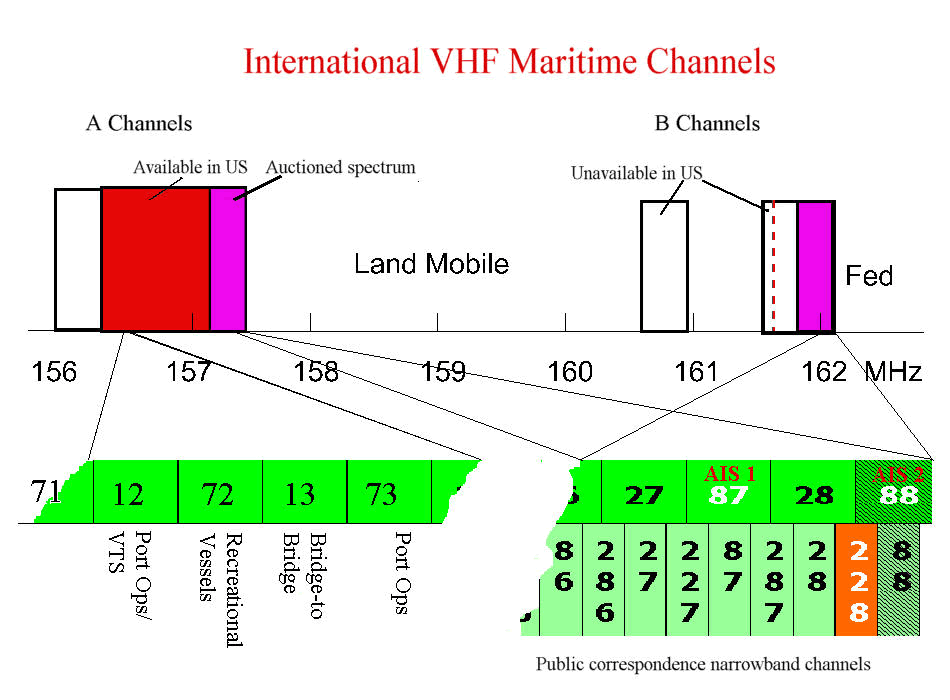
A high-quality combination VHF and AIS antenna was on Gizmo’s shopping list this summer, even though I knew that it’s challenging to do both really well. The USCG Navigation Center spectrum diagram above tells the story (as does their detailed U.S. VHF Channel list): The marine VHF audio channels cluster around 157 MHz while the two main AIS channels are up at 162 MHz. That’s why dedicated VHF and AIS antennas are optimized differently (though each will perform the other job OK).
So for years, I’ve been advocating separate VHF and AIS antennas for maximum performance. But I’ve come to realize that on many boats there are good reasons to use just one antenna — typically along with a quality active AIS/VHF splitter — and several manufacturers now build “broadband” VHF antennas designed to handle the frequency disparity.
Moreover, I was impressed with Doug Miller’s detailed advice on this subject, because he’s helped thousands of Milltech customers with their AIS installs and proven himself a knowledgable and honest counselor in the process. In fact, I highly encourage anyone looking for better AIS and/or VHF performance to read Doug’s essay carefully, especially because I will now jump to the combo antenna I purchased partially on his advice.
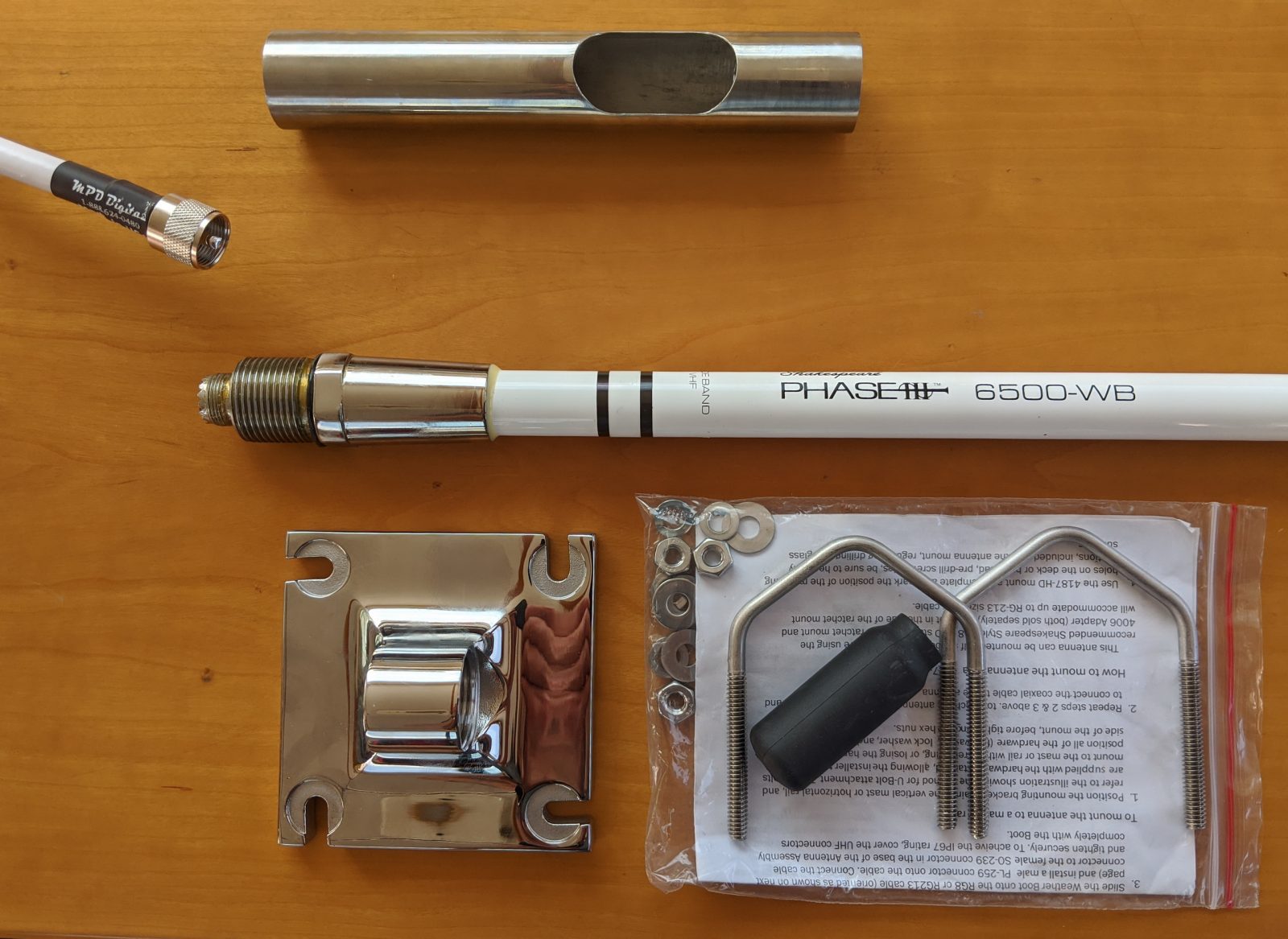
Actually, you’ll see that Milltech sells numerous AIS/VHF antennas, and sailors should particularly note the Vesper Marine masthead whip. Their claim that it “has less than 1.5:1 VSWR at 156 MHz all the way up to 162 MHz” is as good a spec as I could find among several antennas that claim broad VHF frequency performance. But while I do prefer a detachable coax cable like the Vesper’s, I also wanted to use a standard 1″-14 base with a fiberglass antenna that would look more balanced among the several others on Gizmo’s mast spreaders.
At any rate, I count myself lucky to have found the Shakespeare Phase III 6500-WB Broadband 4-footer above, since it’s only listed among Shakespeare commercial antennas and not seen at many recreational marine distributors. But, oddly enough, Walmart sells them and so does Amazon (although the product photo shows a cell phone!), and that $143 price is a bargain for Phase III premium quality (and an 8-year warranty). I’ve never owned an antenna that felt nearly so well built, and the 6500-WB also claims that top “156-162 MHz, VSWR < 1.5:1” broadband performance.
By contrast, check out the 6396-AIS-R Phase III, with a claimed VSWR of <1.5:1 at 162 MHz and a 5 MHZ bandwidth within 2:1 VSWR. Or the 6400-R Phase III VHF with <1.5:1 at 156.8 MHz (Channel 16) plus a 3 MHZ bandwidth within 2:1. Actually, they’d make a great pair if separate AIS and VHF antennas are the goal, especially because they come with the standard Phase III mounting system that makes it easy to install, remove, or replace antenna or cable. But they also cost over $200 apiece, well over from some sources.
Mounting my Phase III 6500 was more challenging, though it did come with the super-rugged base shown in my photo. That complete mount, however, clamps to a sturdy pipe (vertical or horizontal), or bolts to something like the side of a flybridge, and while Gizmo does have both, I was determined to use one of my custom antenna mast platforms.
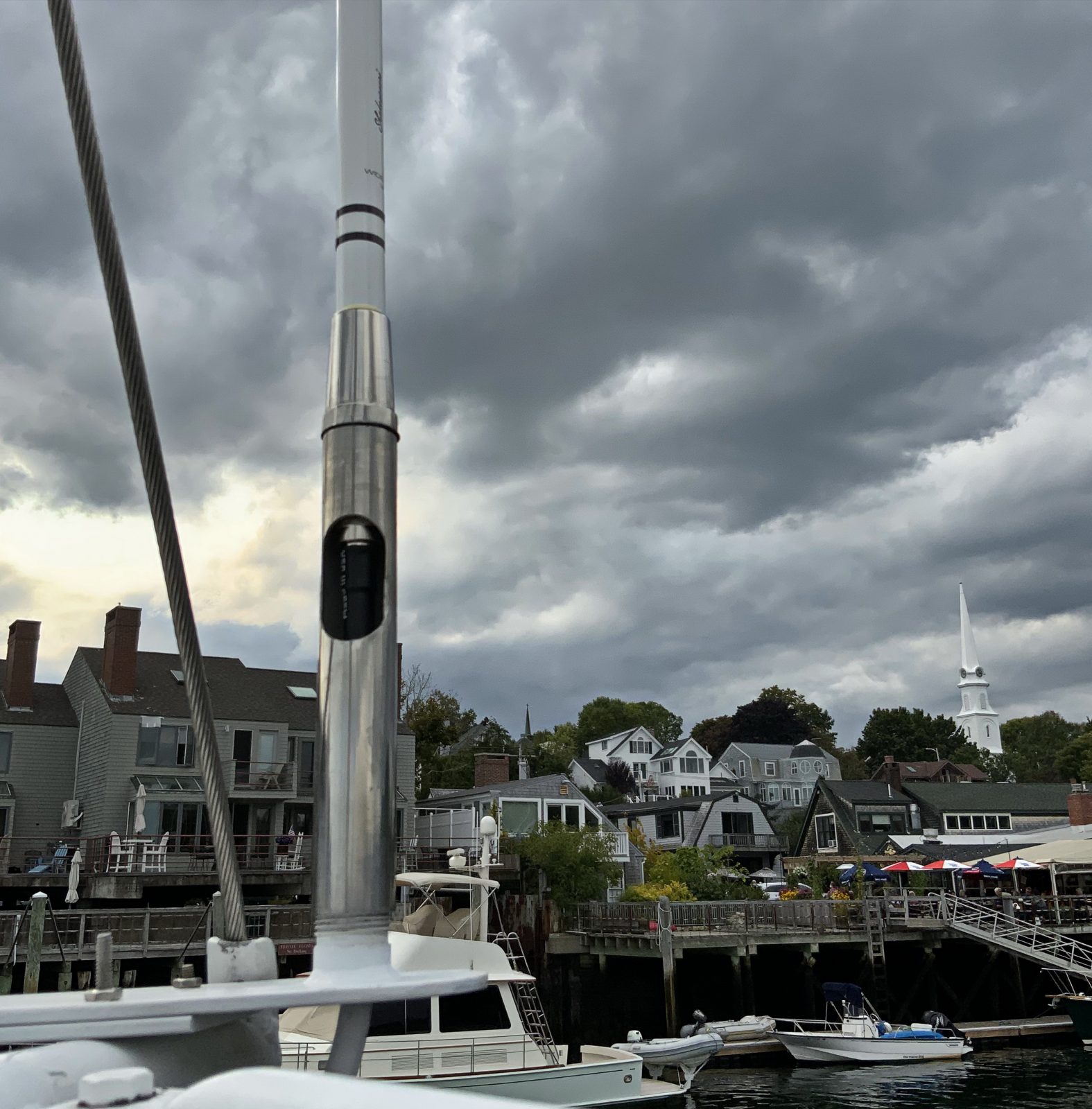
All that’s needed to use the Shakespeare 6500-WB with a standard 1″-14 antenna base is a double female ferrule like the Shakespeare 4006. However, the mystery one I had in stock includes that unusually large hole, and I wish I could link to a source because it turned out to be a significant feature in this case. With needlenose pliers and finger tips I could control the coax cable connector enough to screw the antenna into both the ferrule and cable at the same time, no cable twisting required. In other words, this mount functions something like the regular Phase III mount, though it might not come apart so easily after months of exposure.
Note the super low loss LMR400 coax cable, which I found on Amazon but could have had custom made. Yes, it’s thick and thus hard to fish through narrow cable raceways, but remember Doug Miller’s wise observation: “In my experience, the most important factor is the VHF antenna connected to the AIS system. And when I say VHF antenna, I include the antenna itself, the cable, the connector and the location of the antenna.”
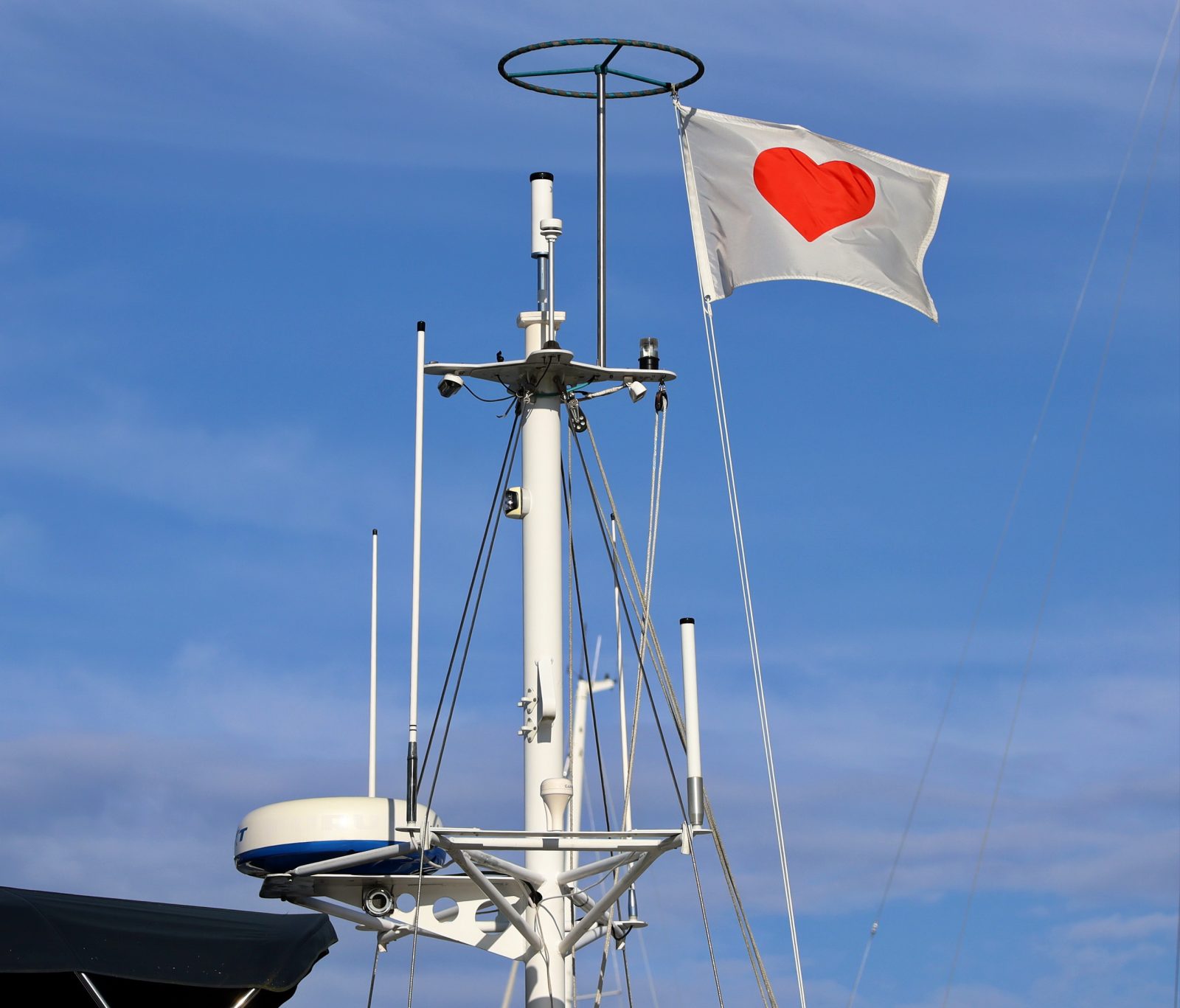
I’m not going to claim that Gizmo’s antennas are ideally located, but they do all work pretty well, inspection and maintenance access is good, and I like to think they look sharp together. The 3 to 4-footers left to right are a Digital Antenna VHF antenna that’s served well for years — sometimes also handling AIS via a Vesper splitter– then the new Shakespeare VHF/AIS and finally the Glomex Glomeasy FM that’s kept me nicely tuned in since 2017.
Meanwhile, Gizmo is usually online thanks to the stubby though excellent Wave WiFi Rogue Reach Dual Band high-power WiFi system or the powerful Cel-Fi Go+ booster with its masthead antenna. Altogether the collection signifies many valuable cruising safety and communications capabilities (and makes me feel very fortunate).
And the heart flag? It’s been flying all summer, first to honor the frontline workers dealing with Covid, but then also for all those working to relieve people suffering from hurricanes, fires, and racial injustice.
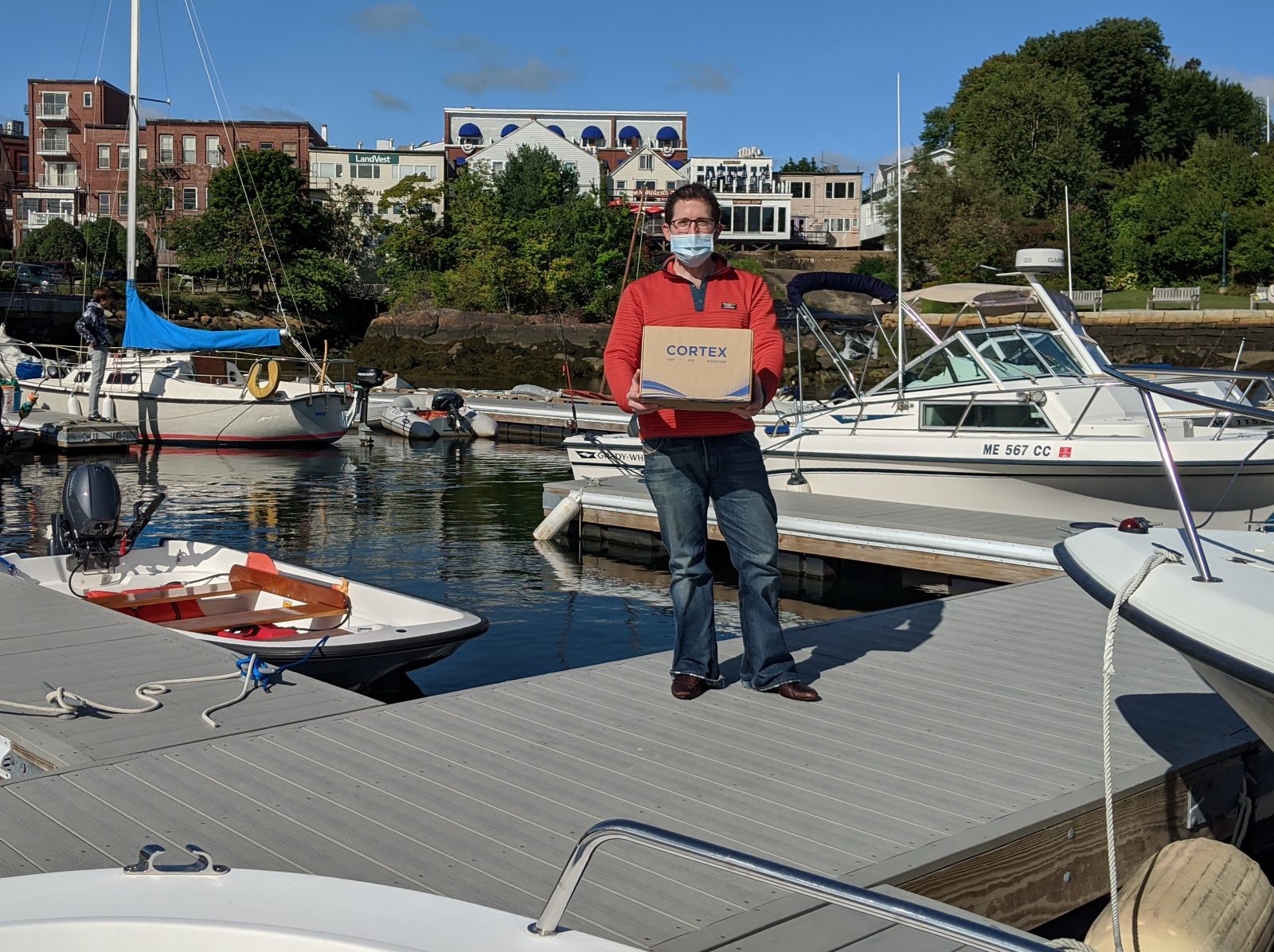
Finally, I’d also like to honor Andrew Golden of Rushton Gregory Communications. I think that most of us in the boating industry know our increased lack of importance in this turbulent world, but Andrew’s still working hard at providing high-quality public relations. Which is to say knowing the products and companies he represents really well, and connecting us to test gear, images, and/or the product managers who can answer further questions.
In this case, Andrew had driven up from Portland to deliver a sample Vesper Marine Cortex AIS/VHF/monitoring system the day after they were delivered from New Zealand (retail inventory went out sooner, which was the right way to go given the delays). And while he did go home with a few fresh lobsters he saw hauled up to recently made over Junior, I almost immediately got the Cortex working with the Shakespeare antenna and will share the mostly wonderful details soon.


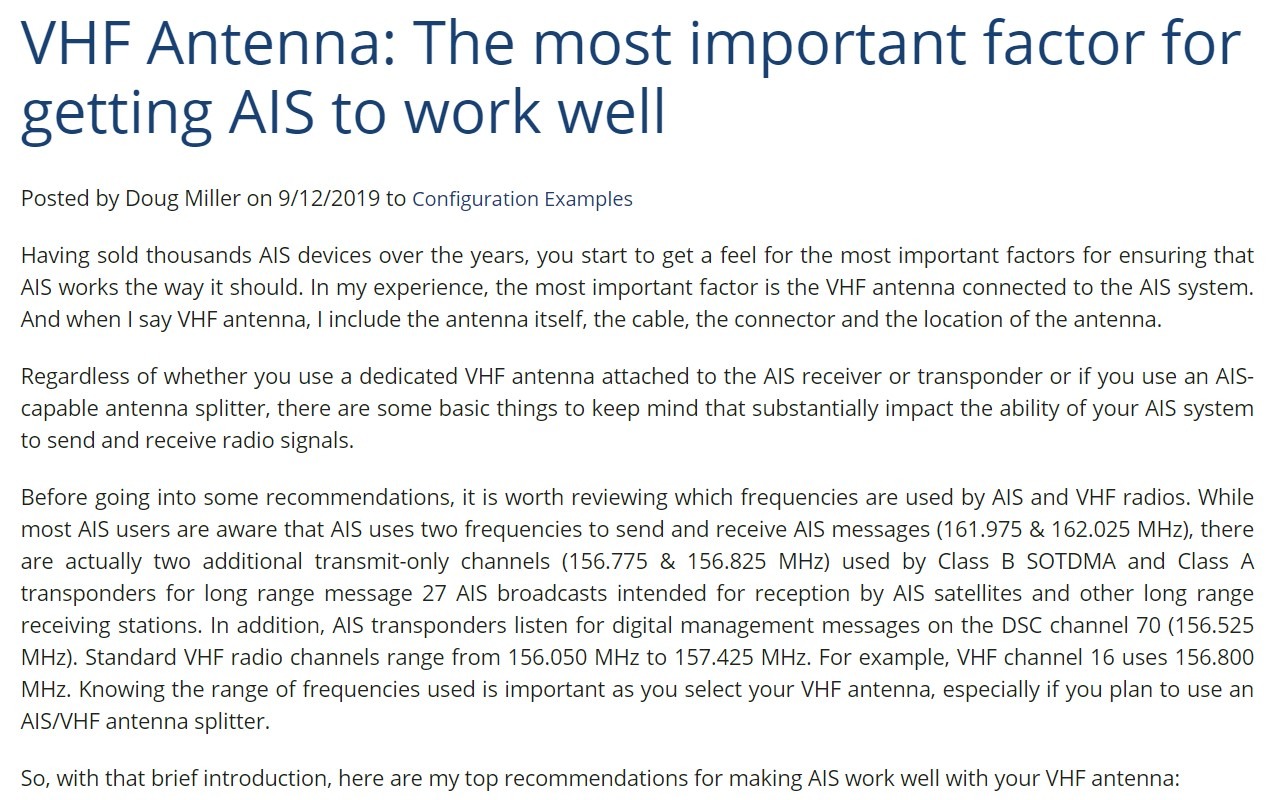

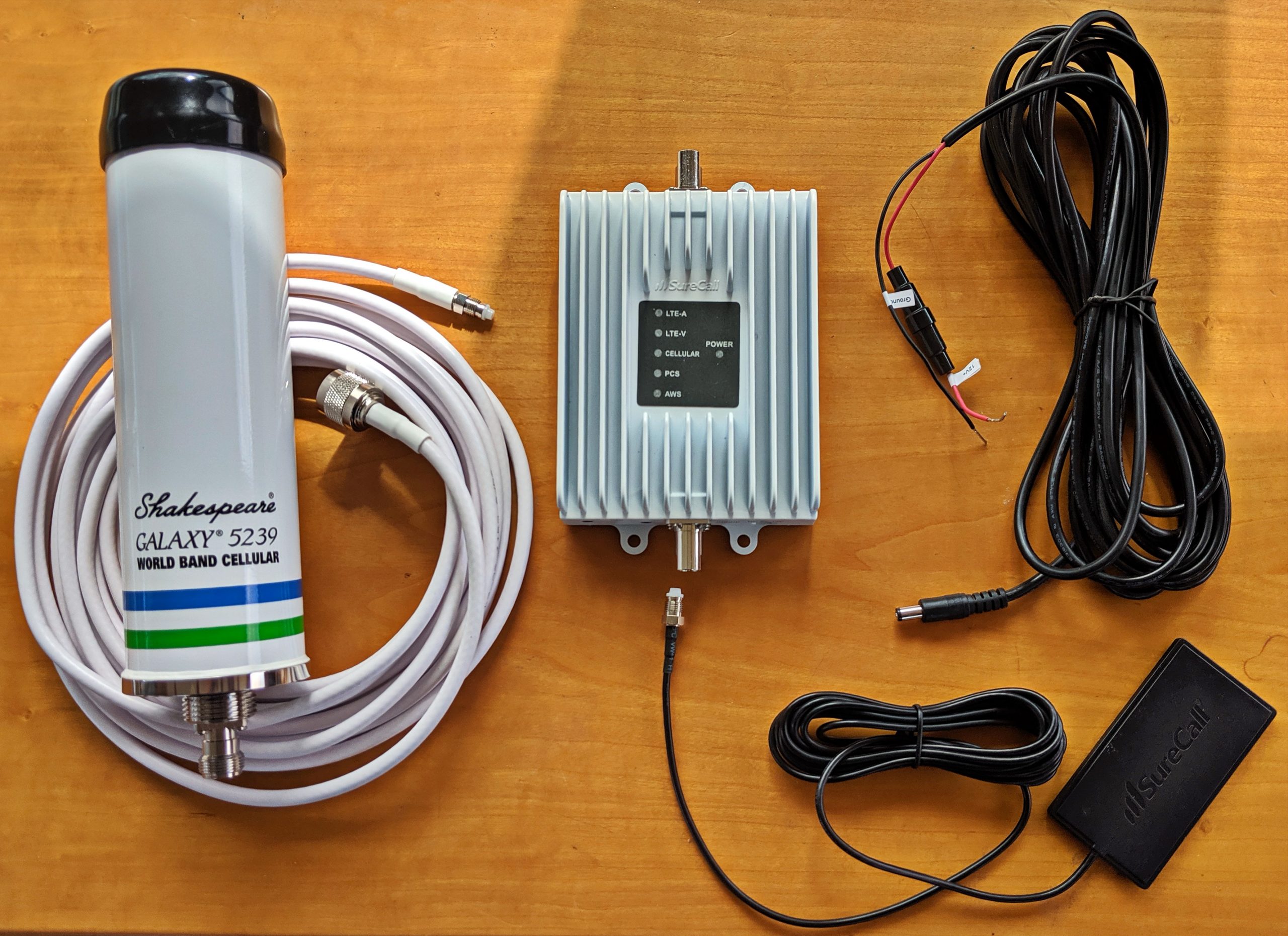










Interesting articles on antennas .. and yes VSWR is imprtant, but its only one of the spec thats important.
Antenna gain and beamwidth /tilt across the desired frequency band of operation are also very important.
There are typically design tradeoffs when desiging “gain” and wide band antennas – to maintain not only VSWR but also gain/beamwidth tilt across the band of interest.
VSWR is very important no question – but doesnt speak to the antenna gain or pattern tilt.
For a narrower bandwidth (eg AIS only freqs, rather than the “whole” VHF marine band) its “easier” to achieve higher gain AND flat VSWR across the desired band in a given size (length) antenna.
So (as always) – its compromise and choice – depending on the circumstances…
Having two separate antennas has some benefit of “redundancy” … albeit voice vs AIS, but in an emergency, you can always swing the AIS antenna across to the VHF (albeit with crappy VSWR)
and I like the higher “gain” (& very low VSWR) that I get from a dedicated AIS antenna.
Thanks, Greg. I didn’t get into antenna gain in this entry largely because I think most readers understand that they can get better dB performance if they can fit and afford taller antennas. And hopefully they also understand the tradeoff, especially sailors. Shakespeare explains well:
https://shakespeare-ce.com/marine/antenna-selector/
Incidentally, almost all the 4-foot VHF/AIS antennas I discussed claim 3dB of gain. But somehow Digital Antenna purports to get 4.5 dB out the same size, like these quality looking Gold Series AIS sticks:
http://www.digitalantenna.com/prods/aisantenna_4.html
Perhaps an illustration of your point?
Hi Ben – the double-female “ferrule” with the big hole you have is a Digital Antenna F114.
WRT antenna gain – for you power guys, the extra gain with a longer antenna is often usable, but for us rag-baggers, not so good if we’re you know, actually sailing!
Thanks, Hartley, but I think the hole in my ferrule is much bigger than the DA F114:
http://www.digitalantenna.com/cgi-bin/shopper.cgi?preadd=action&key=0004F114
In fact, I suspect that my ferrule was custom machined, but I have no recollection about where I got it. Sad.
Yes, looking at your pictures, the one you have is longer than any I’ve ever seen. The Digital Antenna one does have a hole in the side, tho. BTW, for those who need even more bandwidth (like land mobile or amateur) there are some truly wideband antennas out there like the Shakespeare HS-2774-1-R. I’ve had one of those up for 6 years now, and its still going strong from 136 to 170+.
I found the Shakespeare link but it seems oddly short on specs:
https://shakespeare-ce.com/marine/product/hs-2774-1-r-broadband-antenna/
So do you have a low loss way to switch the antenna from one radio to another?
Hi Ben, No, I just have one antenna per radio 🙂 I do have a switch. but I don’t use it anymore. The Shakespeare “installation guide” for the HS-2774-1-R says it’s below 2:1 SWR from 136 to 174. My analysis with both my MFJ-226 and my NanoVNA says that’s right.
For a low-loss VHF switch for just 2 antennas, I’d use one of these: https://www.americanradiosupply.com/opek-cx-201u-2-way-coaxial-antenna-switch-so-239-uhf-connectors/ . They also have them with N connectors, but I’m not sure they are really all that good at microwaves (like for a cellfone or Wifi).
Hi Again, Ben – one other thing for those looking to mount marine antennas on the cheap – 1″ X 14 thread matches 3/4″ pipe – so you can roll your own at the hardware store 🙂
Well, talk about broadband VHF, I just learned of the Digital Antenna 922-M 8-foot 6dB antenna with a claimed VSWR “<1.5:1 at 146-166 MHz (20 MHz)" plus "<2:1 at 134-176 MHz (42 MHz)":
http://www.digitalantenna.com/cgi-bin/shopper.cgi?preadd=action&key=0017992-M
Hi Ben, I have one of these I bought and mounted in 2018, though they went unobtanium right afterwards and have only recently popped up available again. My measurements say it doesn’t really go down to 136 (more like 139/140 MHz) but it does top out in the 170s. If it really has 2 dB more gain than the Shakespeare, I can’t tell. It is slimmer and more tapered than the Shakespeare, though, so it is a bit more attractive. Its also lighter in weight and therefore easier to mount.
FWIW, a friend in USCG Comms says they have lots of the HS-2774-1-R antennas in service and they like ’em a lot.
Hah! Great minds think alike. I have a project underway to reduce the number of VHF antennas from 3x down to 1x on my boat specifically because of a long running conversation Doug and I have been having about AIS and VHF performance. With his data and experience, and testing I have been doing the last month, I have definitely proven that having a correctly tuned, single antenna with quality cable as short as possible from the antenna to the radio is the best solution for me.
I am using the Morad 159Mhz tuned antenna https://www.morad.com/products/vhf-antenna-159-hd-ais which is a match for the Morad antennas I installed last year, just in case I do need to leave one around for some reason. This has had great ratings and reviews as well as an excellent antenna that handles both VHF and AIS well.
For testing, I have been using both the Vesper Cortex with a VHF downstream of it, and two splitters, including the Vesper one I’ve had for a long time. I’ve been using VHF radios from ICOM, Standard Horizon and Furuno as the downstream radio, and as a second radio on another VHF antenna to gauge the quality and strength of the signal. There is a local automated radio check station that has been invaluable in helping me test the real results of the various configurations.
The final setup I hope to settle on is the Vesper Cortex connected to the Morad 159Mhz antenna, and then downstream of that connected to the Cortex VHF/splitter port, the new-ish Standard Horizon GX2400 with remote station as the backup VHF. I will likely leave one more VHF antenna installed but not connected for a few months in case I want the VHF connected directly.
The more data I gather, and the more folks I talk to about single antenna setups, the more I’m learning that it seems like the best of both AIS and VHF worlds which is great for simplifying installations. I’m glad that splitters and technology has improved enough to make this possible.
I look forward to your write-up, Steve. Right now I have the Standard Horizon GX6000 using the Cortex’s exterior splitter (and the original Vesper splitter, since the GX has two antenna ports). So this single 6500-WB antenna is supporting 2x VHF radios, 1 AIS transciever, and 1 AIS receiver. And all seem to be working fine.
In fact, I compared the GX before switching from the comparable DA VHF antenna mounted at a very similar location, and saw no change in number of AIS targets received or VHF WX channels I can hear well (four, which is quite good where Gizmo lays). I also saw/heard the same results with the Cortex VHF.
I don’t know the ultimate setup I’ll settle on, but think I’ll at least keep a second VHF antenna up ready to go if needed.